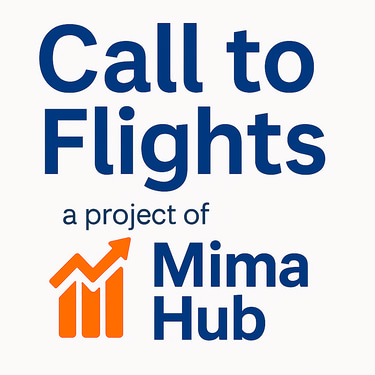Why Urgency Messaging Works Best for Flight Offers
ADS & CREATIVES – SEO PROMPTS
9/15/20257 min read


Understanding Urgency Messaging
Urgency messaging is a marketing strategy designed to create a sense of immediate action among consumers. This technique leverages psychological principles to encourage quick decision-making by presenting opportunities that appear time-sensitive. When implemented effectively, urgency messaging prompts consumers to act swiftly, often resulting in increased sales and enhanced customer engagement. In the travel industry, particularly regarding flight offers, urgency can take various forms, such as limited-time discounts, last-minute deals, or countdown timers. These elements are critical in establishing a perception of scarcity and time limitation.
The core concept behind urgency messaging rests in its ability to trigger an emotional response. By instilling a fear of missing out (FOMO), urgency messaging taps into consumers' innate desire to secure the best deals available. Such an emotional connection is particularly powerful in the travel sector, where consumers frequently seek the most advantageous flight offers. Whether it's a seasonal sale or a flash promotion, the pressure to act quickly can significantly influence purchasing behavior.
Moreover, urgency messaging is often delivered through multiple channels, including websites, emails, and social media. Advertisers may use phrases like "Book now before it's too late!" or "Only three seats left at this price!" to ignite urgency. When consumers encounter such prompting, they are more likely to prioritize the message, often leading to impulsive purchases. As a result, implementing urgency in advertising is not merely a technique; it is a critical factor that determines the effectiveness of marketing campaigns for flight offers.
The Psychological Triggers Behind Urgency
Urgency messaging has become a prominent strategy in marketing, particularly in sectors like travel where time-sensitive offers can significantly influence consumer behavior. Understanding the psychological principles behind this approach reveals its effectiveness in driving immediate action among potential customers. Central to this concept is the idea of FOMO, or Fear of Missing Out, which equates to the anxiety that arises from the thought of losing a rewarding opportunity. When consumers perceive that a flight deal is limited, they are compelled to act quickly to avoid the regret of missing out.
Additionally, the principle of scarcity plays a crucial role in urgency messaging. Scarcity suggests that limited availability enhances the value of an item or offer. Airlines often leverage this by advertising limited seats or short time frames for booking certain flight deals. This tactic triggers a psychological response that motivates consumers to make prompt decisions, as they subconsciously associate scarcity with exclusivity and desirability.
The urgency principle can also be connected to the behavioral concept of loss aversion. Research in behavioral psychology indicates that individuals are more motivated to avoid losses than to acquire equivalent gains. Therefore, when consumers are informed that a flight offer is nearing expiration, the potential loss of the desirable fare prompts quicker decision-making. This motivational trigger can override typical deliberative decision processes, pushing consumers toward immediate action rather than prolonged contemplation.
In summary, urgency messaging effectively captivates consumers through psychological triggers such as FOMO, scarcity, and loss aversion. By understanding these principles, marketers can craft compelling messages that inspire immediate engagement and prompt ticket purchases, ultimately leading to increased conversions in the competitive airline industry.
Crafting Limited-Time Deals for Flight Offers
Creating effective limited-time flight offers requires a well-thought-out strategy to engage consumers and drive prompt action. One of the principal elements to consider is pricing strategy. Competitive pricing can significantly influence a traveler’s decision, and implementing discounts that create an impression of scarcity can make offers more enticing. Price tags that display the original price crossed out next to the promotional price help to visually communicate the value being presented. Using round numbers for pricing can also make offers appear simpler and more appealing.
Timing plays an essential role in the success of limited-time flight offers. Travelers often plan their trips during specific seasons and may be motivated to act quickly when offers coincide with their travel plans. Therefore, it is advisable to carefully choose promotional periods that align with peak travel times or holidays. For instance, launching a sale during the summer vacation season or the Christmas holidays can encourage swift booking behavior among consumers. Additionally, using data analytics to uncover patterns in consumer behavior can help tailor the timing of offers to maximize exposure and urgency.
Articulating urgency through effective messaging can heavily influence consumer behavior. Employing time-sensitive language, such as phrases like “limited seats available” or “book within the next 24 hours,” instills a sense of urgency that compels consumers to act quickly. Furthermore, pairing such language with visual elements, like countdown timers or bold graphics, can effectively reinforce the urgency of the message. Visual cues, paired with compelling text, not only draw attention but also help convey the essence of urgency more clearly, prompting travelers to take action sooner rather than later.
Seasonal Urgency: Making the Most of Holidays and Events
Timing plays a crucial role in the effectiveness of urgency messaging, particularly in the context of flight offers. During peak travel seasons and special events, consumers are often more inclined to book flights if they perceive a limited-time opportunity. This phenomenon can be strategically harnessed by aligning flight promotions with significant holidays and major happenings, such as Christmas, Thanksgiving, or popular festivals.
To create compelling urgency messaging, marketers must first identify key dates when travel demand surges. For instance, periods surrounding school vacations or major sporting events present prime opportunities for airlines to introduce time-sensitive offers. By informing potential travelers that these specials will only be available for a limited time, businesses can push consumers towards making quicker decisions while securing their bookings. This approach not only plays on consumers’ fear of missing out (FOMO) but also leverages the excitement surrounding these occasions.
Additionally, marketing efforts can be tailored to reflect the sentiments often associated with holidays and events. For example, messages that capture the joy of holiday travel or the thrill of attending concerts or sporting events resonate strongly with audiences. Engaging imagery, festive themes, and language that evokes the spirit of the occasion can further amplify the urgency of flight offers. Moreover, employing countdown timers and highlighting the number of seats left can create a visual representation of scarcity, further motivating customers to act swiftly.
By tapping into the emotional and logistical facets of seasonal travel trends, airlines and travel agencies can effectively stimulate a broader response from potential customers. The implementation of urgency messaging aligned with holidays and events leads to countless benefits, including increased engagement and higher conversion rates on flight bookings, ultimately driving revenue during critical travel periods.
Implementing Urgency Messaging in Your Advertising Strategy
In today’s competitive travel market, effectively implementing urgency messaging in your advertising strategy can significantly increase engagement and conversion rates for flight offers. To begin with, identifying the right platforms for dissemination is crucial. Social media channels like Facebook, Instagram, and Twitter allow for dynamic and visually appealing advertisements that can embed urgency messaging in a creative manner. For instance, using countdown timers or highlighting limited time offers can capture the attention of potential travelers effectively.
In addition to social media, email marketing remains a powerful tool for urgency messaging. Crafting compelling subject lines that emphasize limited-time deals or exclusive offers can entice recipients to open emails immediately. Moreover, emails can include visuals such as countdown clocks or striking images of popular destinations that evoke a sense of urgency. Tailoring content to highlight how limited seats or exclusive pricing is available for a short duration enhances the urgency appeal.
When it comes to messaging formats, clear and concise language is vital. Utilize phrases like “Last Chance,” “Only a Few Seats Left,” or “Book Now Before It’s Too Late” to convey urgency and prompt immediate action. Including actionable buttons such as “Reserve Your Spot” or “Get This Deal” can further enhance user engagement.
Furthermore, incorporating A/B testing in your campaigns is essential for optimizing the effectiveness of urgency messaging. By comparing different headlines, visuals, or even call-to-action phrases, you can determine what resonates best with your audience. Analyzing metrics such as click-through rates and conversion rates will provide valuable insights into refining your strategy and maximizing the impact of your urgency messaging.
Measuring the Impact of Urgency Messaging
Understanding the effectiveness of urgency messaging in flight offers requires careful analysis of several key performance indicators (KPIs). By monitoring these metrics, businesses can gain valuable insights into customer engagement and campaign success. One of the primary KPIs to evaluate is the click-through rate (CTR). The CTR measures the percentage of individuals who click on a flight offer after receiving the urgency-driven message. A higher CTR denotes that the messaging resonates well with the target audience, prompting them to take action.
Another critical metric to consider is call conversions. When urgency messaging prompts potential customers to make inquiries via phone or other direct communication channels, it signifies a successful engagement strategy. Tracking the number of calls generated from urgency messaging can help businesses assess whether their messaging effectively motivates customers to seek further information or finalize purchases.
Additionally, analyzing the overall campaign success by evaluating sales conversions is paramount. This involves measuring the number of sales generated from campaigns employing urgency messaging versus those that do not. Comparing these figures helps in determining the impact urgency messaging has on driving sales growth within the context of flight offers.
Moreover, returning on investment (ROI) must be evaluated to ascertain the financial effectiveness of urgency strategies. By outlining the cost of executing urgency messaging campaigns against the generated revenue, companies can gauge their profitability. Interviews, customer feedback, and A/B testing can further enrich the data by providing qualitative insights into consumer perception and responsiveness to urgency tactics.
In summary, effectively measuring the impact of urgency messaging in flight offers involves a comprehensive evaluation of multiple metrics, including click-through rates, call conversions, and overall sales performance, supporting strategic decision-making for future marketing endeavors.
Tips and FAQs on Urgency Messaging for Flight Offers
Implementing urgency messaging effectively in flight offers can significantly enhance customer engagement and conversion rates. Here are some actionable tips for businesses looking to utilize this powerful strategy.
Firstly, it is essential to create a clear and compelling message. A strong call-to-action paired with a defined timeframe can instill a sense of urgency. For instance, phrases such as "Limited time offer" or "Book your flight in the next 24 hours to save 20%" can prompt quicker decision-making among potential travelers. Using a countdown timer on your landing page can further emphasize the fleeting nature of the offer, encouraging customers to act promptly.
Secondly, personalize your urgency messaging whenever possible. Tailoring offers based on user behavior or previous interactions can make the communication more relevant. For example, sending a targeted email to customers who have previously shown interest in specific destinations can drive urgency even further by presenting them with an exclusive offer.
Be mindful of common pitfalls associated with urgency messaging. One crucial aspect is avoiding over-exaggeration. If urgency is constantly promoted without genuine limitations, customers may develop skepticism towards your offers. Additionally, balance is critical; while urgency can spur action, too much pressure can lead to customer resentment. Aim for a tone that encourages action without overwhelming the potential buyer.
Frequently, businesses wonder about the effects of urgency messaging on brand reputation. As long as the message maintains transparency and honesty, urgency can enhance perceived value. When consumers believe they might miss out, they are more likely to prioritize your offer, thereby increasing not just immediate sales but also long-term customer loyalty. Always focus on crafting a message that resonates with the audience's emotions without compromising the integrity of your brand.

Join
Stay updated with our latest insights.
Stay Updated
team@mimahub.com
+62 (817) 3940-82
© 2025. All rights reserved.
